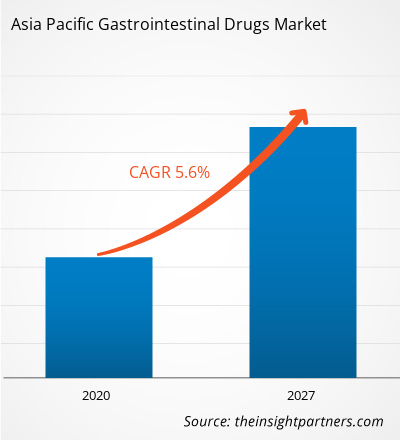The Asia Pacific gastrointestinal drugs market is expected to reach US$ 13,618.35 million by 2027 from US$ 8,868.44 million in 2019; it is estimated to grow at a CAGR of 5.6% from 2020 to 2027.
Rising prevalence of gastrointestinal (GI) diseases, and increase in development of biologics are the key factors driving the growth of gastrointestinal drugs. However, side effects associated with the drugs is the major factor hindering the market growth in Asia Pacific.Gastrointestinal (GI) disorders are the medical conditions related to the digestive system that affect the colon, small and large intestine, and rectum. The disorders include constipation, irritable bowel, ulcerative colitis, and peptic ulcer diseases. These disorders are characterized by various symptoms such as pain, bloating, diarrhoea, nausea, and vomiting. These disorders constitute a large proportion of outpatients and frequent hospital visits. A wide range of GI drugs is commercially available in the market for the treatment of various conditions. Additionally, rising investments in the development of biologics and the emergence of a biosimilar are expected to drive the growth of the market in the forecast period.
Growing prevalence of IBD can be ascribed to poor nutritional choices, including a high intake of ultra-processed foods and trans-fats. Several studies have highlighted the accelerated growth of gastrointestinal diseases in Asian populations during the past two decades. Both incidence and prevalence rates have shown a notable rise, with scientists pointing out that GI diseases are increasingly the cause of morbidity and mortality in Asian countries. In the World Cancer Research Fund’s annual ranking of the top 20 countries with the highest incidence of stomach cancer, Korea (42 per 100,000), Japan (30 per 100,000), and China (23 per 100,000) ranked as 1st, 3rd, and 5th respectively.
Gastrointestinal (GI) diseases, in particular, are becoming common and have been linked to changing environmental factors brought on by improved sanitation, industrialization, changes in diet, and the increased use of antibiotics. Common GI diseases include ulcerative colitis (UC), colorectal cancer, gastroesophageal reflux disease, inflammatory bowel disease (IBD), and Crohn’s disease (CD). Due to these factors, medical device companies in the GI space have been expanding their business operations in Asia. The incidence and prevalence of many GI disorders are highest amongst the very young and the elderly. As the population ages, the disease burden is expected to grow. The incidence and prevalence of IBD have increased in the last few decades. As per the International Foundation for Gastrointestinal Disorders, Inc., IBD is the most common functional GI disorder with a prevalence rate of 10–15%. Also, it is one of the most common conditions for a visit to a doctor.
Countries in the Asia Pacific are facing challenges due to increasing incidences of COVID-19. The outbreak has severely affected the tourism industry and imposed supply chain disruptions; moreover, low-income countries face additional challenges due to the shortage of healthcare infrastructure. Restrictive measures have been put forth in South Korea, Malaysia, Singapore, the Philippines, and India to prevent disease transmission. All these factors will impact gastrointestinal drug market for short period of time due to restrictions on supply chain as well as limited manufacturing capabilities. However, in long run the market has strong potential to boost the growth rate as Asia Pacific is most populated region in the world and one of the strong consumers of over the counter generic medications including gastrointestinal disorder drug products.
Rest of Asia Pacific Gastrointestinal drugs Market, Revenue and Forecast to 2027 (US$ Mn)

- This FREE sample will include data analysis, ranging from market trends to estimates and forecasts.
ASIA PACIFIC GASTROINTESTINAL DRUGS MARKET SEGMENTATION
By Drug Class
- Acid Neutralizers
- Antidiarrheal and Laxatives
- Anti-Inflammatory Drugs
- Antiemetic and Antinauseants
- Biologics
- Others
By Route of Administration
- Oral
- Parenteral
By Application
- Inflammatory Ulcerative Colitis
- Crohn's Disease
- Irritable Bowel Syndrome
- Gastroenteritis
- Celiac Disease
- Others
By Distribution Channel
- Retail Pharmacies
- Hospital Pharmacies
- Online Pharmacies
By Country
- Japan
- China
- India
- South Korea
- Australia
- Rest of APAC
Company Profiles
- Johnson and Johnson Services, Inc.
- GlaxoSmithKline plc
- Celltrion Healthcare Co., Ltd.
- AstraZeneca
- Takeda Pharmaceutical Company Limited
Asia Pacific Gastrointestinal Drugs Report Scope
| Report Attribute | Details |
|---|---|
| Market size in 2019 | US$ 8,868.44 Million |
| Market Size by 2027 | US$ 13,618.35 Million |
| Global CAGR (2020 - 2027) | 5.6% |
| Historical Data | 2017-2018 |
| Forecast period | 2020-2027 |
| Segments Covered |
By Drug Class
|
| Regions and Countries Covered | Asia-Pacific
|
| Market leaders and key company profiles |
- Historical Analysis (2 Years), Base Year, Forecast (7 Years) with CAGR
- PEST and SWOT Analysis
- Market Size Value / Volume - Global, Regional, Country
- Industry and Competitive Landscape
- Excel Dataset



Report Coverage
Revenue forecast, Company Analysis, Industry landscape, Growth factors, and Trends

Segment Covered
Drug Class, Route of Administration, Application, and Distribution Channel, and Country

Regional Scope
North America, Europe, Asia Pacific, Middle East & Africa, South & Central America

Country Scope
Australia, China, Japan, South Korea
Trends and growth analysis reports related to Life Sciences : READ MORE..
The List of Companies - Asia Pacific Gastrointestinal Drugs Market
- Johnson and Johnson Services, Inc.
- GlaxoSmithKline plc
- Celltrion Healthcare Co., Ltd.
- AstraZeneca
- Takeda Pharmaceutical Company Limited

 Get Free Sample For
Get Free Sample For